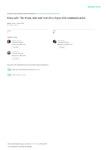Keep safe: The when, why and how of epilepsy risk communication
| dc.contributor.author | Smart, Cordet | |
| dc.contributor.author | Page, G | |
| dc.contributor.author | Shankar, Rohit | |
| dc.contributor.author | Newman, C | |
| dc.date.accessioned | 2021-05-23T09:02:39Z | |
| dc.date.issued | 2020-05-01 | |
| dc.identifier.issn | 1059-1311 | |
| dc.identifier.issn | 1532-2688 | |
| dc.identifier.uri | http://hdl.handle.net/10026.1/17187 | |
| dc.description.abstract |
Purpose Risk communication between clinicians and people with epilepsy (PWE) and their families is under researched. There is limited guidance about when and how to have these discussions. This paper explores the current evidence on quality of risk related conversations in epilepsy and suggests a concept of an evidence-based guideline for person centred structured risk communication. Methods A literature search of four electronic database, Ovid Medline, Ovid Embase, PUBMED, and CINAHL, was conducted by two independent reviewers using relevant search terms following the principals of the PRISMA guidance. No limits were applied. Supplementary searches included using backwards and forwards citation searching. A predesigned inclusion and exclusion criteria was administered to the identified results. Results From 376 results identified, 17 studies met the final criteria of which ten were quantitative, five qualitative and two mixed methods. Perspectives of PWE and clinicians were represented. Extracted data was clustered into three domains: communication initiation (e.g. timing, individual tailoring); communication methods (preference for face to face with neurologists); and communication content (acknowledging the anxiety produced by risk communication, the benefits of being self-aware, normalising risk etc.). No papers focused on conversation structure (e.g. helpful phrases), or the best locations to hold conversations. Conclusion More research is needed to develop structured communication of risk. An attempt has been made to put current evidence into this format. Clearer guidance will enhance clinicians’ confidence in communicating person centred epilepsy risk with PWE and their families thus improving outcomes. | |
| dc.format.extent | 136-149 | |
| dc.format.medium | Print-Electronic | |
| dc.language | en | |
| dc.language.iso | en | |
| dc.publisher | Elsevier | |
| dc.rights | Attribution-NonCommercial-NoDerivatives 4.0 International | |
| dc.rights | Attribution-NonCommercial-NoDerivatives 4.0 International | |
| dc.rights | Attribution-NonCommercial-NoDerivatives 4.0 International | |
| dc.rights | Attribution-NonCommercial-NoDerivatives 4.0 International | |
| dc.rights | Attribution-NonCommercial-NoDerivatives 4.0 International | |
| dc.rights.uri | http://creativecommons.org/licenses/by-nc-nd/4.0/ | |
| dc.rights.uri | http://creativecommons.org/licenses/by-nc-nd/4.0/ | |
| dc.rights.uri | http://creativecommons.org/licenses/by-nc-nd/4.0/ | |
| dc.rights.uri | http://creativecommons.org/licenses/by-nc-nd/4.0/ | |
| dc.rights.uri | http://creativecommons.org/licenses/by-nc-nd/4.0/ | |
| dc.subject | Risk | |
| dc.subject | Families | |
| dc.subject | People with epilepsy | |
| dc.subject | Epilepsy | |
| dc.subject | Communication | |
| dc.title | Keep safe: The when, why and how of epilepsy risk communication | |
| dc.type | journal-article | |
| dc.type | Journal Article | |
| dc.type | Systematic Review | |
| plymouth.author-url | https://www.webofscience.com/api/gateway?GWVersion=2&SrcApp=PARTNER_APP&SrcAuth=LinksAMR&KeyUT=WOS:000537574100023&DestLinkType=FullRecord&DestApp=ALL_WOS&UsrCustomerID=11bb513d99f797142bcfeffcc58ea008 | |
| plymouth.volume | 78 | |
| plymouth.publication-status | Published | |
| plymouth.journal | Seizure: European Journal of Epilepsy | |
| dc.identifier.doi | 10.1016/j.seizure.2020.01.013 | |
| plymouth.organisational-group | /Plymouth | |
| plymouth.organisational-group | /Plymouth/Faculty of Health | |
| plymouth.organisational-group | /Plymouth/Users by role | |
| dc.publisher.place | England | |
| dcterms.dateAccepted | 2021-01-21 | |
| dc.rights.embargodate | 2023-1-31 | |
| dc.identifier.eissn | 1532-2688 | |
| rioxxterms.versionofrecord | 10.1016/j.seizure.2020.01.013 | |
| rioxxterms.licenseref.uri | http://creativecommons.org/licenses/by-nc-nd/4.0/ | |
| rioxxterms.licenseref.startdate | 2020-05-01 | |
| rioxxterms.type | Journal Article/Review |



